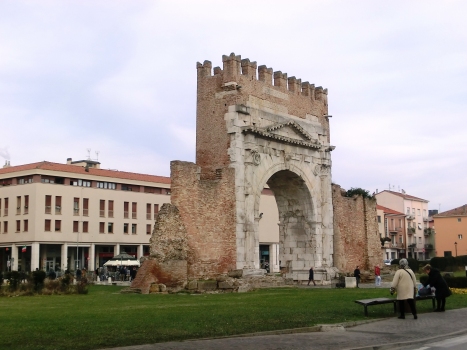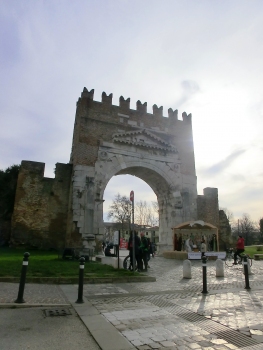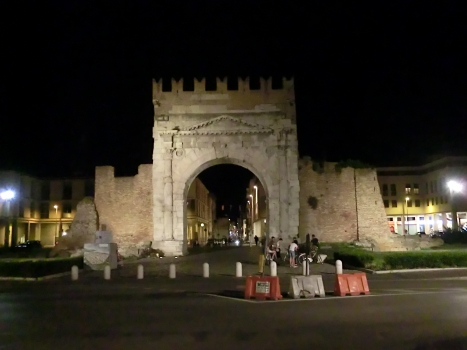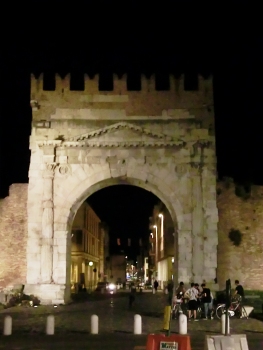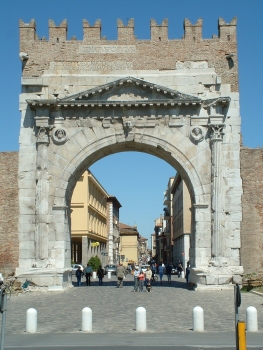General Information
| Completion: | 27 B.C. |
|---|---|
| Status: | in use |
Project Type
| Structure: |
Arch |
|---|---|
| Function / usage: |
City gate |
| Material: |
Masonry structure |
Location
| Location: |
Rimini, Rimini, Emilia-Romagna, Italy |
|---|---|
| Address: | Largo Giulio Cesare |
| Coordinates: | 44° 3' 24.81" N 12° 34' 16.01" E |
Technical Information
There currently is no technical data available.
Excerpt from Wikipedia
The Arch of Augustus at Aosta was dedicated to the Emperor Augustus by the Roman Senate in 27 BC and is the oldest Roman arch which survives. It signaled the end of the via Flaminia, which connected the cities of Romagna to Rome, and spans the modern Corso d'Augusto (the ancient decumanus maximus), which led to the beginning of another road, the via Emilia, which ran northwest to Piacenza.
Ist style is simple but solemn. The central arch, which is of exceptional size, is flanked by two engaged columns with fluted shafts and Corinthian capitals. The four clipei (shields) placed next to the capitals each depict Roman divinities: Jupiter and Apollo on the Roman side, Neptune and Roma facing the city of Rimini.
The gate's principal function, aside from functioning as a city gate, was to support the lavish bronze statue of Augustus, depicted driving a quadriga.
The main peculiarity of this arch is that the archway is especially large for a gate of the time. The explanation must be the fact that the peaceful policy of Augustus the so-called Pax Romana, made a civic gate that could be closed seem unnecessary, since there was no danger of attack.
The battlements on the upper part date to the medieval period (10th century), at which time the city came to be held by the Ghibellines. It remained one of the city gates until the Fascist period, when the city wall was demolished and the arch was left as an isolated monument.
Along with the Bridge of Augustus and Tiberius, it is today one of the symbols of Rimini, so important that it appears on the city's coat of arms.
The inscription above the archway reads:
SENATUS POPVLVSQVE ROMANVS
IMPERATORI CAESARI DIVI IVLIO FILIO AVGVSTO IMPERATORI SEPTEM CONSOLI SEPTEM DESIGNATO OCTAVOM VIA FLAMINIA ET RELIQVEIS CELEBERRIMEIS ITALIAE VIEIS ET AVCTORITATE EIVS MVNITEIS
The Senate and People of Rome [gave this arch]
to Imperator Caesar Augustus, son of the divine Julius, Imperator seven times, Consul seven times and consul-elect for an eighth time, for the via Flaminia and the other very distinguished roads of Italy too which have been repaired by his auctoritas.
Text imported from Wikipedia article "Arch of Augustus (Rimini)" and modified on July 23, 2019 according to the CC-BY-SA 4.0 International license.
Participants
Currently there is no information available about persons or companies having participated in this project.
Relevant Web Sites
Relevant Publications
- (2016): The Arch of Augustus in Rimini: The internal structure determined with a special tomography. Presented at: Structural Analysis of Historical Constructions (SAHC) 2016, Leuven, Belgium, 13-15 September 2016.
- About this
data sheet - Structure-ID
20071275 - Published on:
18/06/2016 - Last updated on:
28/05/2021

